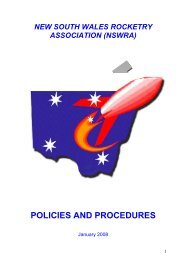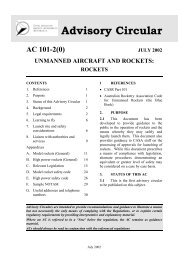NSWRA 2 page brochure Version 12 - NSW Rocketry Association
NSWRA 2 page brochure Version 12 - NSW Rocketry Association
NSWRA 2 page brochure Version 12 - NSW Rocketry Association
You also want an ePaper? Increase the reach of your titles
YUMPU automatically turns print PDFs into web optimized ePapers that Google loves.
Are you looking for somewhere<br />
to launch rockets?<br />
The New South Wales <strong>Rocketry</strong> <strong>Association</strong> (<strong><strong>NSW</strong>RA</strong>)<br />
was formed in June 1997 and is a not-for-profit<br />
incorporated association whose charter is to promote safe<br />
model rocketry in <strong>NSW</strong>. It provides access to insurance, air<br />
clearance, organised events, and launching areas.<br />
<strong><strong>NSW</strong>RA</strong> membership is open to anyone aged 9 years or<br />
older who has an interest in rocketry. People of all ages<br />
are welcome to come and watch.<br />
Those new to rocketry are encouraged to ask for advice<br />
from experienced rocketeers. You may also use the club<br />
equipment for your first rocket launches, for a nominal fee.<br />
To fly rockets regularly you will need to become a member.<br />
Membership fees as at April 2013 (per year):<br />
Full $150<br />
Family $160<br />
Junior/student $40<br />
Where do we launch?<br />
The <strong><strong>NSW</strong>RA</strong> launch site at Doonside is near the corner of the Great<br />
Western Highway and Doonside Road. The club holds regular launch<br />
days on the last Saturday and the second Sunday of each month<br />
starting at 8am. The Civil Aviation Safety Authority (CASA) has given<br />
approval at this site to launch up to 2,000ft or 600m.<br />
No launches are held in strong wind, rain, or in a fire ban.<br />
Please feel free to contact us by email: nswra@nswrocketry.org.au<br />
www.nswrocketry.org.au
Model <strong>Rocketry</strong> FAQ<br />
What are model rockets made of?<br />
The nose, body, and fins of model rockets use lightweight, non-metal parts. Materials used are typically<br />
plastic, cardboard and balsa wood.<br />
How does a typical rocket work?<br />
Model rockets use commercially available, authorised and certified solid fuel motors. The total power of the<br />
motor is designated by a letter. Each letter has up to twice the power of the preceding letter. Eg a “C” motor is<br />
twice as powerful as a “B” motor, which is twice as powerful as an “A” motor.<br />
When the motor is ignited, the rocket is pushed forward until all the propellant is burnt. After a few seconds<br />
delay, a small ejection charge in the motor pushes off the nose, allowing the recovery device (such as a<br />
parachute) to deploy. The rocket descends slowly back to the ground, ready to be prepared to launch again.<br />
How high do they go? How fast?<br />
Depending on the rocket and the motor, model rockets can achieve altitudes of more than 300m at speeds up<br />
to 500kph. Unless launching with a club, it is advisable that you use the smaller motors recommended for the<br />
rocket, unless you don’t want to see it again.<br />
Can anyone buy rockets?<br />
Virtually anyone can buy a rocket. However, the purchase of motors is controlled. You must be over 18 to<br />
purchase motors with a propellant mass no greater than 15g (ie ‘C' class). In <strong>NSW</strong> you must also be a<br />
member of a recognised model rocket club to buy and use larger motors.<br />
Where can I launch rockets?<br />
Model rockets can be launched to a maximum altitude of <strong>12</strong>2m (400ft) in controlled airspace, provided it is not<br />
a movement area or runway of an aerodrome, and it is not the approach or a departure path of a runway of an<br />
aerodrome.<br />
You must not launch a rocket in a way that creates a hazard to an aircraft, person or property.<br />
You need a large cleared area free of trees, power lines, buildings, dry bush and dry grass, and have<br />
permission from the landowner.<br />
Motor Class<br />
Minimum Site<br />
Dimension (metres)*<br />
¼A - ½A 15<br />
A 30<br />
B 60<br />
C <strong>12</strong>0<br />
D 150 In <strong>NSW</strong>, these motors and larger are only legally<br />
E 300 available to members of a recognised model rocket club<br />
*Minimum site dimension is the length of the shortest side of a rectangular field, or the shortest diameter of an oval<br />
What do I need to launch a rocket?<br />
You will need a launch pad with rod and a launch controller with cables at least 5m long. You will have these<br />
items if you purchase a “starter set”. You will need batteries for the controller, a packet of motors with igniters<br />
(do not try to ignite motors with anything other than the supplied igniters), and recovery wadding. Another<br />
option is to join a club and use their launch equipment – then you just need motors (with igniters) and wadding.<br />
Is it dangerous?<br />
Model rocketry has an outstanding safety record. The Model <strong>Rocketry</strong> Safety Code is a set of rules that ensure<br />
this good safety record is maintained. A copy of the code is included with the pack of motors. There may also<br />
be a copy with your rocket. Follow the Model Rocket Safety Code and you will find model rocketry to be an<br />
enjoyable and safe hobby/sport for everyone.<br />
Where can I get more information?<br />
Attend a local rocketry club launch day. Introduce yourself and ask questions.<br />
The <strong>NSW</strong> <strong>Rocketry</strong> <strong>Association</strong> (www.nswrocketry.org.au) launches regularly in the western suburbs of<br />
Sydney.




